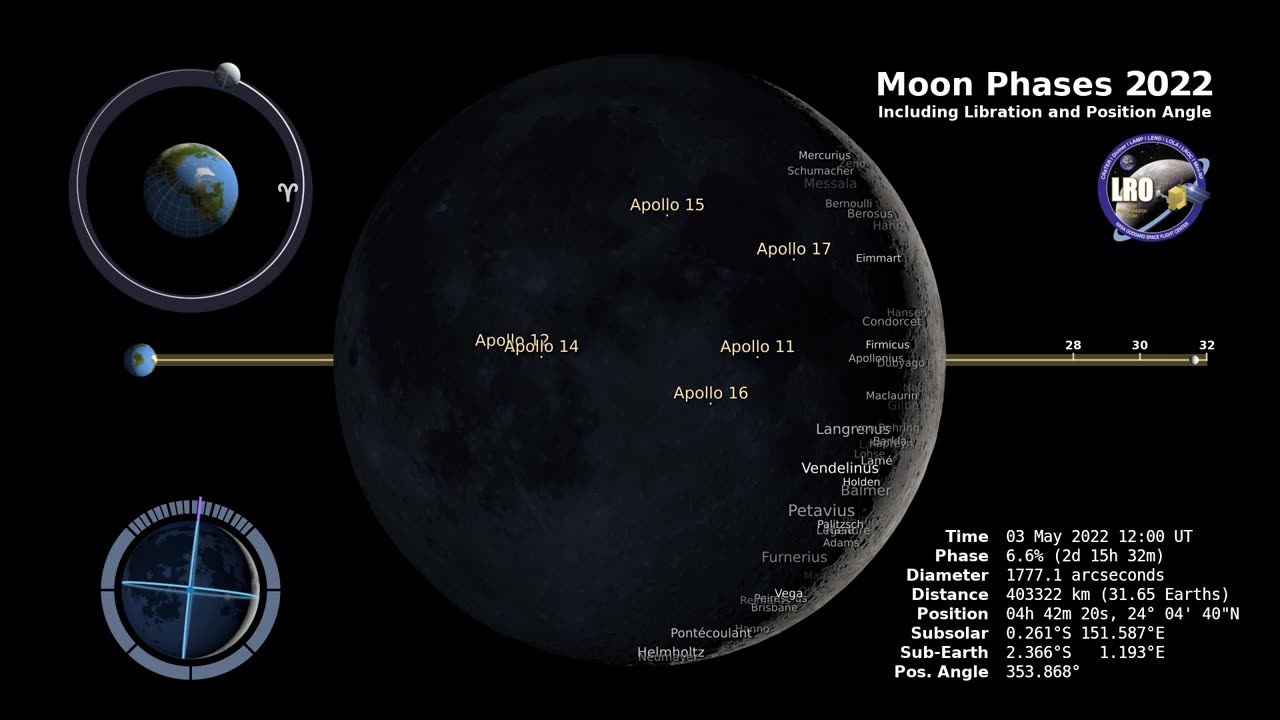Premium Only Content

Moon Phase and Libration, 2022
In the realm of celestial wonders, the moon remains an ever-fascinating object of study and observation. Throughout 2022, astronomers, space enthusiasts, and stargazers alike were treated to a celestial spectacle of moon phases and libration that offered both aesthetic beauty and scientific intrigue. This article delves into the captivating lunar phenomena that graced our night skies during the year, shedding light on the dynamic dance of Earth's closest neighbor.
Moon Phases:
The moon's phases have been a subject of human fascination for centuries, and 2022 was no exception. As Earth's natural satellite orbits our planet, it cycles through distinct phases, each marked by the amount of its illuminated hemisphere visible from Earth. These phases, ranging from the waxing crescent to the waning crescent, provide not only a mesmerizing visual spectacle but also vital insights into lunar and celestial mechanics.
Throughout 2022, avid skywatchers had the opportunity to witness these phases shift and transform like the ever-changing face of a celestial clock. The year kicked off with a stunning New Year's Day full moon, bathing the night sky in a silvery glow. As the months passed, the moon transitioned through its various phases, enchanting viewers with its ethereal beauty. For astronomers, these phases served as crucial markers for observing specific lunar features and planning missions to explore the moon's surface.
Libration:
While moon phases offer a predictable rhythm to the moon's appearance, libration adds an element of intrigue and variability to lunar observations. Libration refers to the subtle, oscillating motion of the moon as it orbits Earth, which allows us to glimpse slightly beyond its apparent "fixed" face. In 2022, lunar libration was a phenomenon that captivated astronomers and lunar enthusiasts alike.
The moon's libration is a result of a combination of factors, including its elliptical orbit, tilt, and rotation. As a consequence, it appears to wobble ever so slightly, revealing parts of the moon's eastern and western edges that are usually hidden from view. This phenomenon creates a tantalizing visual effect, as lunar features on the moon's limb, such as craters, mountains, and valleys, become briefly visible during libration.
Throughout 2022, lunar libration allowed for enhanced views of the moon's hidden treasures. Astronomers took advantage of these moments to capture detailed images of lunar landscapes and to better plan for future lunar exploration missions. Observers on Earth marveled at the subtle shifts in the moon's appearance, providing a constant reminder of the dynamic interplay between celestial bodies in our night sky.
In conclusion, 2022 was a remarkable year for moon phase and libration enthusiasts. The ever-changing lunar phases continued to inspire wonder and reflection, while the fascinating libration phenomenon added an extra layer of complexity to our observations of the moon. As we looked up at the night sky throughout the year, we were reminded of the beauty and intricacy of our cosmic neighborhood, and the moon remained a steadfast companion in our exploration of the cosmos.
In the realm of celestial wonders, the moon remains an ever-fascinating object of study and observation. Throughout 2022, astronomers, space enthusiasts, and stargazers alike were treated to a celestial spectacle of moon phases and libration that offered both aesthetic beauty and scientific intrigue. This article delves into the captivating lunar phenomena that graced our night skies during the year, shedding light on the dynamic dance of Earth's closest neighbor.
Moon Phases:
The moon's phases have been a subject of human fascination for centuries, and 2022 was no exception. As Earth's natural satellite orbits our planet, it cycles through distinct phases, each marked by the amount of its illuminated hemisphere visible from Earth. These phases, ranging from the waxing crescent to the waning crescent, provide not only a mesmerizing visual spectacle but also vital insights into lunar and celestial mechanics.
Throughout 2022, avid skywatchers had the opportunity to witness these phases shift and transform like the ever-changing face of a celestial clock. The year kicked off with a stunning New Year's Day full moon, bathing the night sky in a silvery glow. As the months passed, the moon transitioned through its various phases, enchanting viewers with its ethereal beauty. For astronomers, these phases served as crucial markers for observing specific lunar features and planning missions to explore the moon's surface.
Libration:
While moon phases offer a predictable rhythm to the moon's appearance, libration adds an element of intrigue and variability to lunar observations. Libration refers to the subtle, oscillating motion of the moon as it orbits Earth, which allows us to glimpse slightly beyond its apparent "fixed" face. In 2022, lunar libration was a phenomenon that captivated astronomers and lunar enthusiasts alike.
The moon's libration is a result of a combination of factors, including its elliptical orbit, tilt, and rotation. As a consequence, it appears to wobble ever so slightly, revealing parts of the moon's eastern and western edges that are usually hidden from view.In the realm of celestial wonders, the moon remains an ever-fascinating object of study and observation. Throughout 2022, astronomers, space enthusiasts, and stargazers alike were treated to a celestial spectacle of moon phases and libration that offered both aesthetic beauty and scientific intrigue. This article delves into the captivating lunar phenomena that graced our night skies during the year, shedding light on the dynamic dance of Earth's closest neighbor.
Moon Phases:
The moon's phases have been a subject of human fascination for centuries, and 2022 was no exception. As Earth's natural satellite orbits our planet, it cycles through distinct phases, each marked by the amount of its illuminated hemisphere visible from Earth. These phases, ranging from the waxing crescent to the waning crescent, provide not only a mesmerizing visual spectacle but also vital insights into lunar and celestial mechanics.
Throughout 2022, avid skywatchers had the opportunity to witness these phases shift and transform like the ever-changing face of a celestial clock. The year kicked off with a stunning New Year's Day full moon, bathing the night sky in a silvery glow. As the months passed, the moon transitioned through its various phases, enchanting viewers with its ethereal beauty. For astronomers, these phases served as crucial markers for observing specific lunar features and planning missions to explore the moon's surface.
Libration:
While moon phases offer a predictable rhythm to the moon's appearance, libration adds an element of intrigue and variability to lunar observations. Libration refers to the subtle, oscillating motion of the moon as it orbits Earth, which allows us to glimpse slightly beyond its apparent "fixed" face. In 2022, lunar libration was a phenomenon that captivated astronomers and lunar enthusiasts alike.
The moon's libration is a result of a combination of factors, including its elliptical orbit, tilt, and rotation. As a consequence, it appears to wobble ever so slightly, revealing parts of the moon's eastern and western edges that are usually hidden from view. This phenomenon creates a tantalizing visual effect, as lunar features on the moon's limb, such as craters, mountains, and valleys, become briefly visible during libration.
Throughout 2022, lunar libration allowed for enhanced views of the moon's hidden treasures. Astronomers took advantage of these moments to capture detailed images of lunar landscapes and to better plan for future lunar exploration missions. Observers on Earth marveled at the subtle shifts in the moon's appearance, providing a constant reminder of the dynamic interplay between celestial bodies in our night sky.
In conclusion, 2022 was a remarkable year for moon phase and libration enthusiasts. The ever-changing lunar phases continued to inspire wonder and reflection, while the fascinating libration phenomenon added an extra layer of complexity to our observations of the moon. As we looked up at the night sky throughout the year, we were reminded of the beauty and intricacy of our cosmic neighborhood, and the moon remained a steadfast companion in our exploration of the cosmos.
-
 15:23
15:23
Exploring With Nug
12 hours ago $2.60 earnedWe Went Scuba Diving in the River and Found Incredible Lost Relics!
10.3K2 -
 DVR
DVR
Rallied
7 hours ago $11.99 earnedBATTLEFIELD 6 DOMINATION WITH RAL !BF6 #BF6 #Ad
98.9K6 -
 24:23
24:23
MYLUNCHBREAK CHANNEL PAGE
22 hours agoIstanbul Should NOT Exist - Pt 5 of 5
27.9K18 -
 15:31
15:31
Chris Harden
2 days ago $1.88 earnedOvershadowed by Gary | Lake Station, Indiana
16K3 -
 8:27:16
8:27:16
SLS - Street League Skateboarding
19 days agoSLS Paris 2025 🛹 | OCTOBER 11, 2025
417K33 -
 6:15:10
6:15:10
SpartakusLIVE
9 hours ago$120,000 WZ Tourney || #1 Tournament Champion RETURNS
30.6K1 -
 47:47
47:47
Athlete & Artist Show
10 hours ago $1.25 earnedSeason 6 Premiere, NHL Season Preview!
22.4K2 -
 17:17
17:17
Advanced Level Diagnostics
20 days ago $2.58 earnedWhy won't this Mack Truck Charge!
28.1K4 -
 1:33:51
1:33:51
Steve-O's Wild Ride! Podcast
16 days ago $13.33 earnedJohn C. Reilly's Surprising Connection To Jackass (And Beef With Weeman!)
120K25 -
 LIVE
LIVE
StoneMountain64
6 hours agoBattlefield 6 Unlocks and Challenges
68 watching